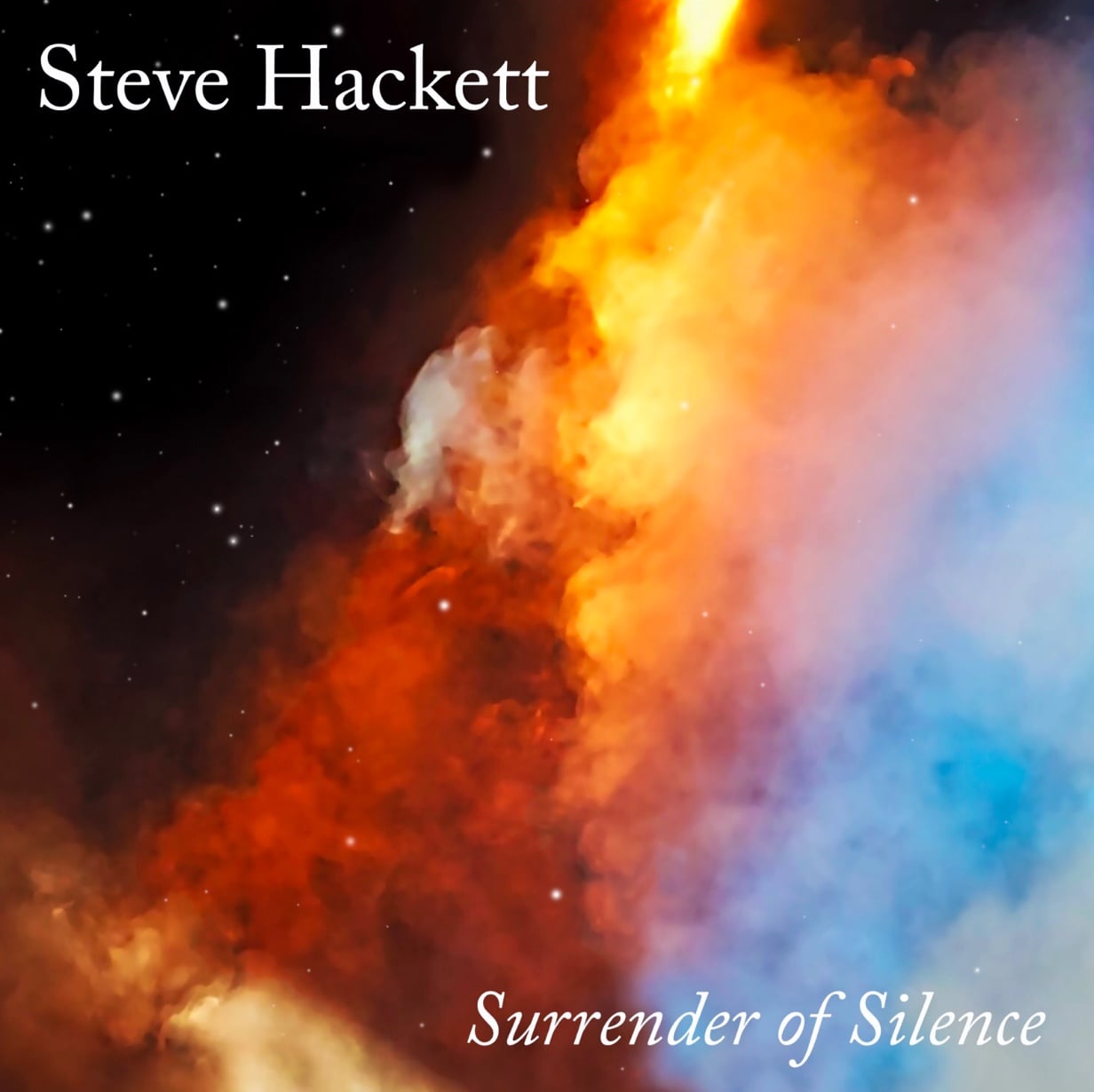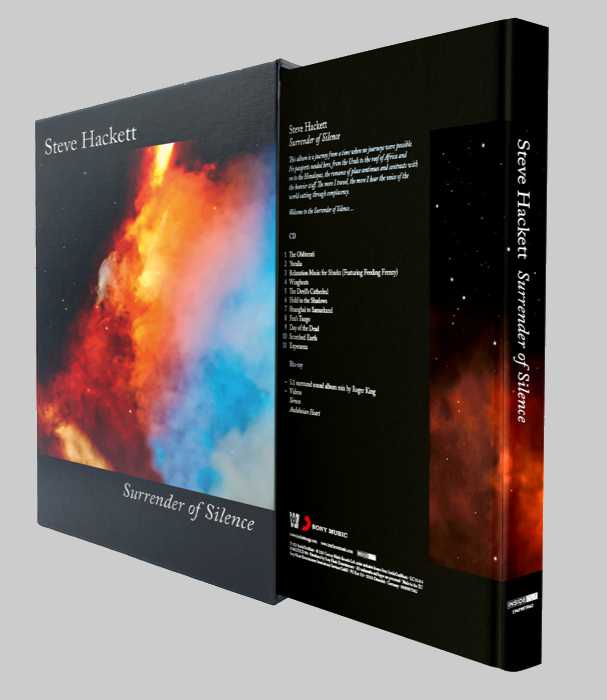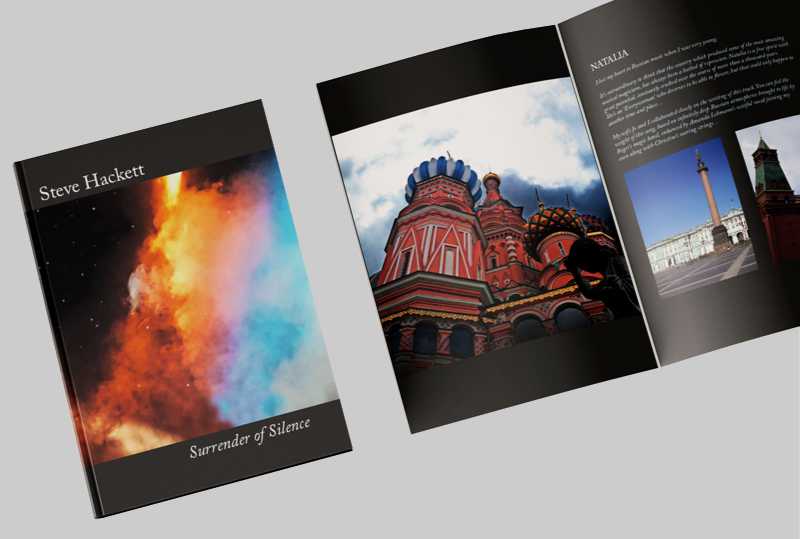- Artikel
- Lesezeit ca. 8 Minuten
Steve Hackett – Surrender Of Silence – info and review
Barely nine months after his acoustic album Under A Mediterranean Sky Steve Hackett presents his new rock album, Surrender Of Silence.

Steve Hackett’s output of the last years is remarkable – with Surrender Of Silence he already presents his second studio album this year after the acoustic-instrumental Under A Mediterranean Sky (the 28th solo album altogether) – this time again an “electric” album with vocals. And he wants to return with a bang – out of the lockdown. In our interviewin May 2021 he told a lot about the creation and the character of the album.
Well, Steve has already set the bar pretty high with this. His last three albums Wolflight, The Night Siren and At The Edge Of Light all had the same flair – we see it as a kind of trilogy – and quite a few fans at least wished for a different production, a different sound. In this respect, his statements in our interview made people take notice.
Quite objectively, Steve produces the largest output in the Genesis camp. There are new albums every 1-2 years, live albums from every tour and Steve is also featured as a guest on many albums by colleagues. So there are also different expectations among the fans: On the one hand, people want to hear a Hackett as versatile and multi-layered as possible. Others would prefer a leaner album – that is, without orchestrations and with fewer instruments. Most, however, see potential for improvement, especially in the sound.
Surrender Of Silence starts with an intro and closes with an outro. So Steve deliberately wants to take us on a journey. And already in the intro, The Obliterati, the course seems to be set – a concise guitar dramatic, science fiction-like keyboards, Hackett-typical drums, various guitar patterns – then a rather opulent orchestration … this strongly reminds of his last albums. With the ideas for his guitar playing alone, this piece could have been made into two or three instrumentals. Nevertheless, The Obliterati is a statement.
Natalia, on the other hand, takes a calmer approach. Steve’s singing sometimes reminds of times of To Watch The Storms, at the same time the choir seems a bit too lush or maybe out of place. In addition, there are, for example, between the first chorus and the second verse sound gimmicks that seem very lost in the context of the overall arrangement. In the middle of the quite restless piece there is then a break, before returning somewhat abruptly to the chorus. The orchestrations and choral passages are a bit too heavy and leave the piece too little air to breathe. One has the feeling in places – this was already offered in a different variation on one of the last albums. There was clearly more potential in it here.
Relaxation Music For Sharks is not stingy with orchestration either. But here the loud element is also brought to the foreground and next to the drumming of Nick D’Virgilio we hear a strong Steve playing. Here the orchestral elements fit much better than on Natalia. But what exactly qualifies the piece for a relaxing music for sharks apart from the beginning and the end remains to be explored.
Wingbeats unfortunately doesn’t work at all and is probably the weakest track of the album (and curiously the first single). The African sounds and the African choir vocals seem much too put on, the verses are very constructed and the vocals are overproduced. It sounds very much like a construction kit production. And that’s a pity, because the guitar theme would leave a lot of room for better ideas.

The Devil’s Cathedral stands out because Nad Sylvan and not Steve sings the track – apart from the Genesis Revisited IIalbum and Inca Terra on The Night Siren, this is the only track with Nad on vocals on a Steve Hackett solo album. The song title justifies the use of an opulent church organ sound in the intro. The opener is followed by a straight rock theme, along with an accomplished verse melody and solid drumming from Craig Blundell. Then follows an almost overdone orchestral excursion before the tempo is picked up. The original theme has been abandoned altogether, and so Nad’s reintroduced vocals are a completely different melody. Basically, this piece is a flawless forecast number, compactly presented in six and a half minutes. As such the piece works very well. But: One would have liked to hear a pure song version of it. The melody up to the middle is great! However, Steve has cited himself again with this piece. The part starting at 2:55 is pretty much identical with the passage starting at 3:18 on the GTR track Imagining.
The straight rock number then comes with Held In The Shadows. Rather calm verses carried by an acoustic guitar and a slamming chorus, driven by Craig’s drumming.
On what is probably the album’s most proggy track, we hear an old acquaintance on drums: Phil Ehart, known from Kansas, but also from Steve’s album Please Don’t Touch, plays drums on Shanghai To Samarkand. In addition, there are some exotic instruments, whose use Steve granted more and more space in the last years. Steve doesn’t dwell on classical song structures for long – almost after the first verse (or more precisely: the introductory vocal part) he takes us into a kind of ambient/Hackett sphere, before a rather rocking bridge forms a kind of intermediate highlight. Suddenly oriental sounds form the main theme afterwards and Steve plays an incredible acoustic guitar part. This is probably what he meant in the interview when he stated that he can play things today that he couldn’t play 20 years ago. The finale is again orchestral … too orchestral.
Besides Held In The Shadows, Fox’s Tango is another straight rock number (and it was the second single). Striking here – besides a great vocal by Steve – is also the concise bass.
Another piece with a rather classical song structure at the beginning is Day Of The Dead. It remains overall – also compared to Held In The Shadows, Fox’s Tango or the following track, but rather inconspicuous. The middle part is quite pleasing, though, but the tempo change is somehow predictable. The dudelic noises at the end really didn’t have to be – hadn’t we left that behind?
For this Scorched Earth reconciles. Interestingly, the title translagted means something similar like Sierra Quemada from the album Guitar Noir. However, the two tracks have nothing to do with each other. Scorched Earth is a real ballad and works perfectly. Guitars and orchestration leave enough room for the melody and beautiful atmosphere of the song.
An outro closes the album and Esperanza is a curiosity for some German fans. A certain similarity to “Auferstanden aus Ruinen” (GDR national anthem) is certainly unintentional, but somehow recognizable.
The silence has not declared surrender on this album, but in fact Steve has let it crash again more. In some cases, it navigates tracks into a maze, in many places it is just too much and one has quite the feeling that certain tracks could have been arranged and produced in different, better way. But now Steve has presented us the tracks in this form. And that leaves ambivalent feelings. A real further development since Wolflight is not what Surrender Of Silence is. In addition, the preference for lush, orchestral sounds more or less crushes many interesting parts on the album. Many tracks contain very nice ideas, but are complicated by somewhat abrupt changes of direction without need. This definitely works once, as on the beautiful Shanghai to Samarkand, but other tracks, such as Natalia or Wingbeats, suffer. The Devil’s Cathedral is an exception and a special track in that regard. It can be done that way, but it’s a bit of a shame regarding the strong melody and structure in the opening section and it took a different direction in the second part.
Steve plays partly breathtaking guitar parts on Surrender Of Silence, also the bass lines of Jonas Reingold and the parts of the drummers are a lot of fun. The sound is unfortunately once again too thin, it doesn’t stand out. One often has the feeling that the tracks could sound much better. Also the construction kit move (an African choir here, an orchestral carpet there) is not helpful in the long run and if used too often and has become a repeating element for several albums. Thus, it is no coincidence that the best moments of the album are the tracks with a fairly clear structure: The Obliterati intro, Held In The Shadows, the first part of The Devil’s Catheral, Fox’s Tango and the beautiful Scorched Earth. In addition, Shanghai To Samarkand is a flawless world music / prog number that is really well done.
Friends of his last albums will also enjoy Surrender Of Silence. Long-time fans will probably wish for a little less orchestra, a reduced use of exotic instruments, more straightforward songs and above all a fresher sound.
Thus, the album leaves us with an ambivalent feeling. Nevertheless, we are of course also grateful that Steve still regularly releases new material.
Author: Christian Gerhardts
Formats:
The album will be released on September 10 and is available for pre-order everywhere, i.e. amazonUK. Available formats are a CD/Blu-ray Mediabook, a 2LP/CD, standard CD and digital album. There will also be special editions on vinyl again.
The bonus Blu-ray contains the album in 5.1 surround as well as bonus videos from the previous album.
The CD/Blu-ray package is a high quality book, two images are below.


01. The Obliterati (02:17)
Roger King: Keyboards, programming & orchestral arrangements
Jonas Reingold: Bass
Christine Townsend: Violin, viola
02. Natalia (06:17)
Roger King: Keyboards, programming & orchestral arrangements
Amanda Lehman: Vocals
Jonas Reingold: Bass
Christine Townsend: Violin, viola
03. Relaxation Music For Sharks (Featuring Feeding Frenzy) (04:36)
Roger King: Keyboards, programming & orchestral arrangements
Jonas Reingold: Bass
Christine Townsend: Violin, viola
Nick D’Virgilio: Drums
04. Wingbeats (05:20)
Roger King: Keyboards, programming & orchestral arrangements
Amanda Lehman: Vocals
Durga McBroom: Vocals
Lorelei McBroom: Vocals
05. The Devil’s Cathedral (06:31)
Roger King: Keyboards, programming & orchestral arrangements
Craig Blundell: Drums
Nad Sylvan: Vocals
Jonas Reingold: Bass
Christine Townsend: Violin, viola
Rob Townsend: Soprano sax, tenor sax, bass clarinet, dizi
06. Held In The Shadows (06:20)
Roger King: Keyboards, programming & orchestral arrangements
Craig Blundell: Drums
Amanda Lehman: Vocals
Jonas Reingold: Bass
07. Shanghai To Samarkand(08:27)
Roger King: Keyboards, programming & orchestral arrangements
Phil Ehart: Drums
Malik Mansurov: Tar
Ubaidulloev Sodirkhon Saydulloevich: Dutar
Christine Townsend: Violin, viola
Rob Townsend: Soprano sax, tenor sax, bass clarinet, dizi
08. Fox’s Tango (04:21)
Roger King: Keyboards, programming & orchestral arrangements
Jonas Reingold: Bass
Nick D’Virgilio: Drums
09. Day Of The Dead (06:25)
Roger King: Keyboards, programming & orchestral arrangements
Amanda Lehman: Vocals
Christine Townsend: Violin, viola
Rob Townsend: Soprano sax, tenor sax, bass clarinet, dizi
10. Scorched Earth (06:03)
Roger King: Keyboards, programming & orchestral arrangements
Craig Blundell: Drums
Amanda Lehman: Vocals
Jonas Reingold: Bass
Christine Townsend: Violin, viola
11. Esperanza (01:04)
Roger King: Keyboards, programming & orchestral arrangements
Produced by Steve Hackett and Roger King
All tracks recorded and mixed by Roger King at Siren, UK
Track 7 additional engineering by Tamas Barabas at Grammy Studio, Budapest, Hungary for Malik Mansurov, with thanks to Attila Égerhazi
Tracks 3 & 8 additional engineering by Shawn Dealey, assisted by Rachel Leonard for Nick D?Virgilio at Sweetwater Studios, Fort Wayne, USA
Track 7 additional engineering by Will McPhaul and Steve Rawles for Phil Ehart at Reel 2 Reel Studios, Jonesboro, USA
Mastered by Roger King at Siren
Discussion
In our forum there is a thread about the new album (click here). There you can exchange your expectations and after the release also your opinions about the album itself.
